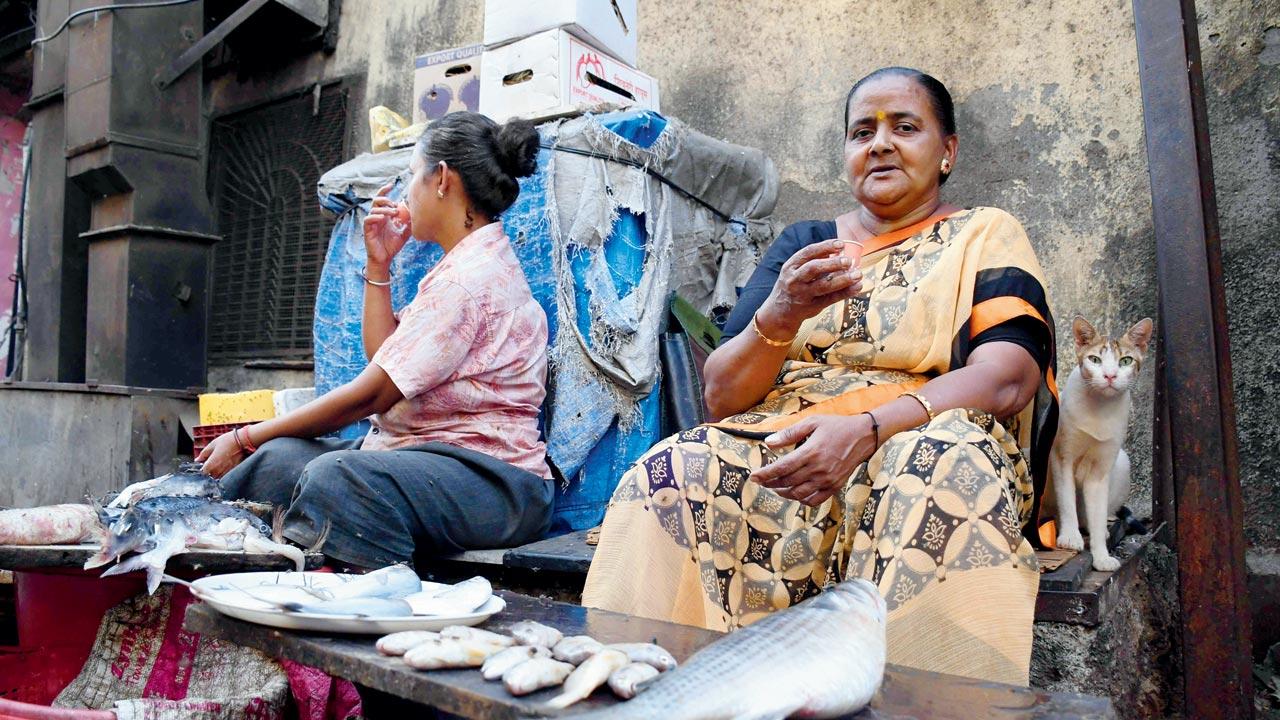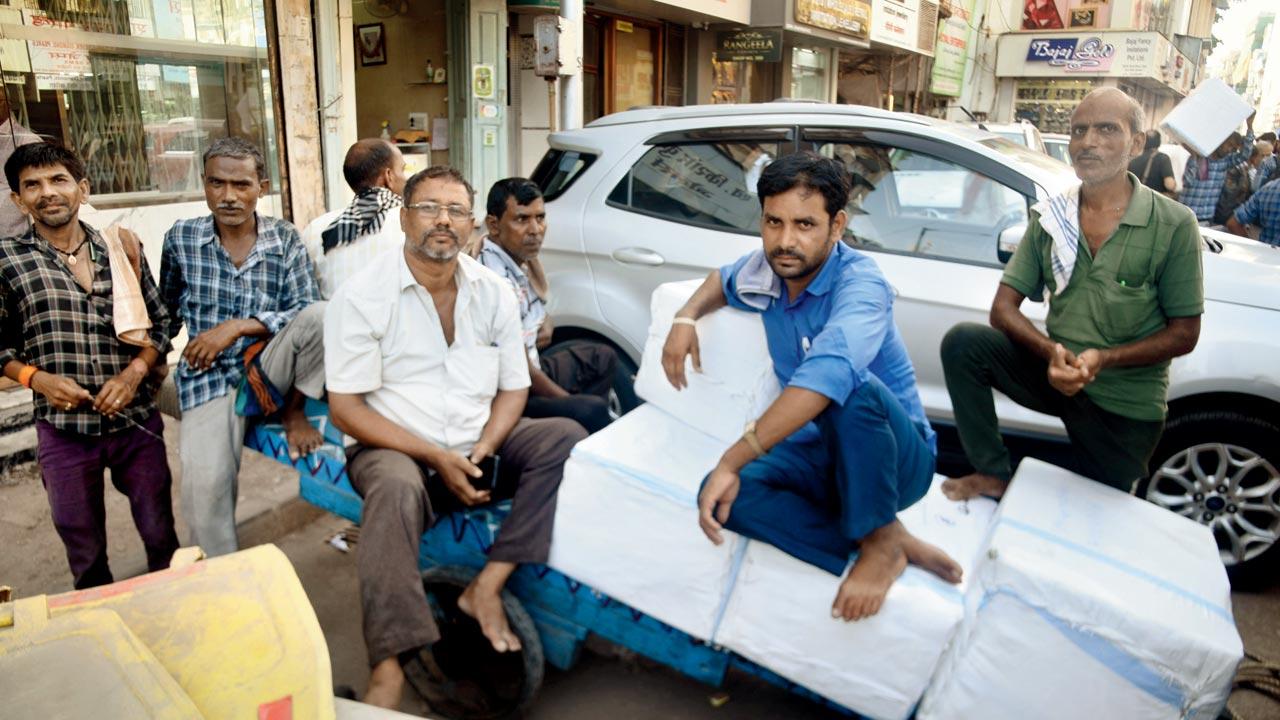While we complain in air-conditioned offices about the scorching heat, the men and women in the city’s street economy go about their lives aided by chaas, kala chasma and topis

Haresh Shamji Singhadia, a potter from Kumbharwada, Dharavi, says he cannot do without his tea, even though it’s not advisable in the extreme conditions in that he works. Pic/Pradeep Dhivar
At 11.30 am, Sumati Ganesh Dingankar can’t take it anymore. She abandons her basket of fish placed on the corner-side of the footpath, and heads to the nearby juice vendor. There’s a wooden board above her basket, with four pomfret and a pair of boi; a pocket-sized umbrella has been left open next to a tiny stool, where she otherwise sits, calling out to passersby. But, today, the sun is beating down, making it impossible for the 52-year-old fishmonger to work. Those arriving at her makeshift dukaan on a footpath near Shrikant Palekar Marg in Chira Bazaar will have to wait. Dingankar has gone to buy herself a glass of ice-cold watermelon juice. She returns with two of them—one for her fishmonger friend, who is slicing a surmai thinly for a customer.
ADVERTISEMENT
Dingankar was among the unfortunate few who lost her stall—one that she claims was owned by three generations of her family—when the 150-year-old Chira Bazaar fish market was demolished for Metro 3 construction work. While the 100-odd fishmongers were promised an alternative space and rent, Dingankar’s husband passed away while negotiations were on. She didn’t find place on the rent roll of the Mumbai Metropolitan Region Development Authority. “I lost out on their monthly '10,000 stipend, due to which I can’t rent a space. Now, I am forced to sell fish on the streets,” she tells us. With no shade or roof overhead, selling fish in this apocalyptic heat is agonising.
 Sumati Ganesh Dingankar seen selling fish on Shrikant Palekar Marg in Chira Bazaar, on a weekday evening. She drinks watermelon juice to beat the heat. Pic/Ashish Raje
Sumati Ganesh Dingankar seen selling fish on Shrikant Palekar Marg in Chira Bazaar, on a weekday evening. She drinks watermelon juice to beat the heat. Pic/Ashish Raje
Last week, the India Meteorological Department issued heatwave warnings for parts of Mumbai and Thane. While the Santa Cruz observatory recorded day-time temperature of 36.9 degrees Celsius, in Thane it shot to 39.9. Humidity levels were also between 72 and 80 per cent.
The worst-hit are those working on Mumbai’s streets. The vagaries of this merciless summer have left them vulnerable to cramps, exhaustion, dehydration and heat strokes. According to a World Bank report titled Climate Investment Opportunities in India’s Cooling Sector, which was released in December last year, “nearly 75 per cent of India’s workforce (or 380 million people) depend on heat-exposed labour, at times working in potentially life-threatening temperatures”. By 2030, the report states that “India may account for 34 million of the projected 80 million global job losses from heat stress associated productivity decline”.
 Hand-cart puller Omprakash Yadav (third from left) parks his cart on the roadside, if and when the heat gets too intense. Pic/Sameer Markande
Hand-cart puller Omprakash Yadav (third from left) parks his cart on the roadside, if and when the heat gets too intense. Pic/Sameer Markande
Dr Anjal Prakash, Research Director at Bharti Institute of Public Policy, ISB and lead author on the Intergovernmental Panel on Climate Change, says that because of climate change, heatwaves will be more common. “They are going to persist,” says Prakash, “and will be more and more unpredictable—that means we cannot plan [for them ahead of time]. Climate scientists, and policy makers in the government will have to work together to find solutions. The problem is that the current heat action plan is not consistent across states, and many of these are only on paper. The Central ministry will have to issue guidelines and advisories to the state, including working hours where people can avoid the heat, like the way it is done in the Middle East.” What worries him most is that labourers, small and independents vendors and those belonging to the lower socio-economic class “don’t have a voice in the process of policy-making... nobody bothers
about them”.
Dingankar, who takes cover below the awning of a jewellery shop, says though she is unable to bear the heat, she can’t miss a day of work as the only breadwinner at home. She picks up her fish from fisherwomen in Colaba before coming here daily at 8.30 am. “I leave at 1 in the afternoon... after lunch I go and do sweeping work in two homes. I return to the market at 6 pm, when it gets cooler.” To prevent spoilage, the fish is placed in a bucket of ice. “I only buy a limited quantity to sell for the day... nothing extra.” There’s always a cold water bottle handy, which she places on her head when she starts feeling dizzy. Otherwise, it is juices. “I barely make Rs 200-300 daily [by selling fish]. Pehle jaisa dhanda nahi raha. Nobody sits on the road out of choice.”
 Gateway of India photographer Akhilesh Pandey doesn’t step out without his sunglasses and cap. Pic/Sameer Markande
Gateway of India photographer Akhilesh Pandey doesn’t step out without his sunglasses and cap. Pic/Sameer Markande
On the crowded Sheikh Memon Street near Crawford Market, hand-cart pullers are visible by the dozen. Despite the peak afternoon heat, they refuse to stop moving their carts because it can lead to chaos on the narrow stretch where pedestrians and vehicles jostle for space. “Hume yaha rukna mana hai,” one of them informs us. In a narrow lane adjoining the road, we find a small group of haath-gaadi wallahs resting near their tarpaulin-wrapped cartons.
Omprakash Yadav hails from Jaunpur in Uttar Pradesh, and has been pulling hand-carts in the city for the last 30 years. “This year, the heat is very bad... aisa lagta hain ki badan jal jayega. Kabhi, kabhi, halat bahut kharaab ho jata hai,” he tells us. He hauls boxes holding imitation jewellery and clothes from Crawford Market to Masjid Bunder or Sandhurst Road stations from 10 am to 10 pm. “We circle the market at least 50 times daily,” he says. To prevent dehydration, he sips lemon juice or warm water. “Cold water is a strict no-no. It can cause cough and cold... none of us can afford falling sick and losing a day’s worth of pay.”
 Police naik Minaj Asif Khan, who spends nearly seven to eight hours on the road, keeps herself hydrated with water. Pic/Satej Shinde
Police naik Minaj Asif Khan, who spends nearly seven to eight hours on the road, keeps herself hydrated with water. Pic/Satej Shinde
Thirty five-year-old Akhilesh Pandey, a Gateway of India photographer, has been lugging his DSLR since 8 in the morning. At 5 pm, the heat is still intense. “When the sun is overhead, I go and relax under a tree, splash some water on my face and drink nariyal paani,” says the resident of Badhwar Park Colaba, who is originally from Bihar. During tourist season, which is now, Pandey only takes a break once every 15 days. But, he has his gear to protect himself, he says: “I always wear a cap and sunglasses.” Apart from the black one that he is wearing, we see two different-coloured shades hooked onto his shirt. That’s for novelty,
he smiles.
In Kumbharwada, Dharavi, it’s not just the ongoing heatwave that’s burning the potter community. Having to fire the traditional mud bhattis (kiln) through the day to bake clay pots means an environment of unrelenting heat and smoke. “We are used to this,” says Haresh Shamji Singhadia, whose family has worked in bhattis for generations. “But in the summer, we do feel a lot of weakness; we try and avoid working in the afternoons or in direct sun,” he says. They, however, continue kindling the kiln with bales of cotton or wood through the day. “Upar ka dhoop or bhatti ka aag... bahut problem ho jata hai.” Singhadia and other bhatti workers drink a lot of chhaas and water. “We avoid eating oily or ‘heaty’ foods,” he says. Fish and vegetables are preferred over meats. “Many of us drink less tea, but I need a cup every hour or so,” he says, adding, that he hopes that they can someday switch to smoke-free bhattis. “It will make such conditions bearable,” he says.
Thursday afternoon is a busy one for Police Naik Minaj Asif Khan. Just minutes before we meet her, she was on Bandra reclamation, attending to a high-profile cavalcade. Working in the Bandra traffic division, Khan, who is a national-level weightlifter, spends nearly seven hours on the road daily—it’s one of the busiest routes and sees a lot of VIP movement. The division works in two shifts—either 7 pm to 3 pm or 3 pm to 11 pm. “Mornings are exceptionally hot,” says the single mother to a nine-year-old daughter, “I have been working in the police force for the last 20 years, and I can tell you that this time the weather has been unusually bad. But we can’t complain. We have to be alert all the time, and heat cannot be an excuse.”
All traffic police personnel have been given strict orders to stay constantly hydrated. Since heatwave alerts were issued, the department sends cartons of water bottles to the thana every day, she says. Khan, who doesn’t step out without a cap and shades, also keeps sunscreen at hand. “It’s another thing that I don’t get the time to apply it every hour,” she says, adding, “I have to focus on the road, not on my skin.”
 Subscribe today by clicking the link and stay updated with the latest news!" Click here!
Subscribe today by clicking the link and stay updated with the latest news!" Click here!







